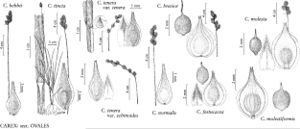Difference between revisions of "Carex bebbii"
Proc. Amer. Acad. Arts 37: 478. 1902.
FNA>Volume Importer |
imported>Volume Importer |
||
| (2 intermediate revisions by 2 users not shown) | |||
| Line 8: | Line 8: | ||
}} | }} | ||
|common_names=Carex de Bebb | |common_names=Carex de Bebb | ||
| + | |special_status={{Treatment/ID/Special_status | ||
| + | |code=F | ||
| + | |label=Illustrated | ||
| + | }}{{Treatment/ID/Special_status | ||
| + | |code=E | ||
| + | |label=Endemic | ||
| + | }} | ||
|basionyms={{Treatment/ID/Basionym | |basionyms={{Treatment/ID/Basionym | ||
|name=Carex tribuloides var. bebbii | |name=Carex tribuloides var. bebbii | ||
| Line 52: | Line 59: | ||
|publication title=Proc. Amer. Acad. Arts | |publication title=Proc. Amer. Acad. Arts | ||
|publication year=1902 | |publication year=1902 | ||
| − | |special status= | + | |special status=Illustrated;Endemic |
| − | |source xml=https:// | + | |source xml=https://bitbucket.org/aafc-mbb/fna-data-curation/src/2e0870ddd59836b60bcf96646a41e87ea5a5943a/coarse_grained_fna_xml/V23/V23_652.xml |
|genus=Carex | |genus=Carex | ||
|section=Carex sect. Ovales | |section=Carex sect. Ovales | ||
Latest revision as of 20:42, 5 November 2020
Plants densely cespitose. Culms 20–90 cm; vegetative culms inconspicuous with few leaves clustered at apex. Leaves: sheaths white-hyaline or green-veined, sometimes papillose, summits U-shaped, not distally expanded; distal ligules 2.2–6 mm; blades 3–4 per fertile culm, 11–25 cm × 1.7–4.2 mm. Inflorescences mostly dense, brown, 1.1–3 cm × 5–14 mm; proximal internode 1–4 mm; 2d internode 1.4–3.4 mm; proximal bracts scalelike, with bristle tips shorter than inflorescences. Spikes 3–10, usually overlapping, ovoid to globose, 4–10 × 3–7 mm, base rounded or truncate, apex rounded. Pistillate scales reddish brown, usually with green or whitish to brown midstripe, lanceolate, 2.5–3.5 mm, shorter and narrower than perigynia, apex acuminate or acute. Perigynia ascending to ascending-spreading, light to dark reddish brown, conspicuously 3+-veined abaxially, faintly or basally 1–3-veined adaxially, winged to base, ovate or elliptic, plano-convex, 2.5–3.8 × (1–)1.2–2 mm, 0.35–0.45 mm thick, 1.9–2.5 times as long as wide, margin flat, including wing 0.2–0.5 mm wide, 1b ciliate-serrulate at least distally; beak reddish brown at tip, flat, ± ciliate-serrulate, abaxial suture with reddish brown-hyaline margin, distance from beak tip to achene 1.2–2.2 mm. Achenes ovate or elliptic, 1–1.3 × 0.6–0.9 mm, 0.3–0.4 mm thick. 2n = 68, 70.
Phenology: Fruiting early summer.
Habitat: Wet places with calcareous or neutral soils, gravelly lakeshores, stream banks, meadows, forest seeps
Elevation: 0–2100 m
Distribution

Alta., B.C., Man., N.B., Nfld. and Labr., N.W.T., N.S., Ont., P.E.I., Que., Sask., Alaska, Colo., Conn., Idaho, Ill., Ind., Iowa, Maine, Mass., Mich., Minn., Mont., Nebr., N.H., N.J., N.Y., N.Dak., Ohio, Oreg., Pa., S.Dak., Utah, Vt., Wash., Wis., Wyo.
Discussion
In addition to typical perennial behavior, Carex bebbii may reach reproductive stage from seed in a single season, thus behaving as a facultative annual. Carex athrostachya and C. crawfordii may share this reproductive feature.
Selected References
None.
